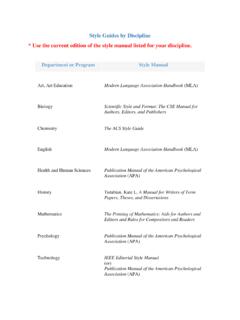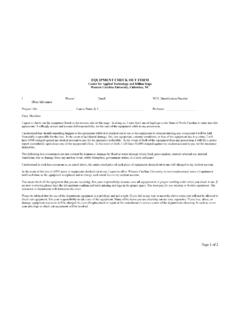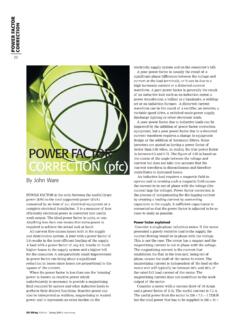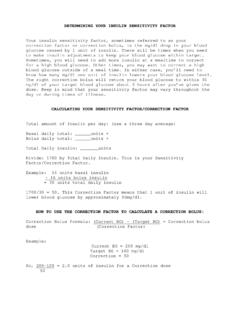Transcription of Advanced Insulin Management: Using Insulin-to-Carb …
1 A dietetic practice group of the Diabetes Care and EducationAdvanced Insulin management : Using Insulin -to-Carb Ratios and correction factors A nutrition resource for living well with diabetes * American Diabetes AssociationIf you are Using background and meal-time Insulin therapy (longacting Insulin + rapid-acting Insulin or on an Insulin pump), you may benefit from Using an Insulin -to-carbohydrate ratio and a blood glucose correction factor to determine your meal-time Insulin dose. Learning to adjust your Insulin dose to the amount of food you eat provides flexibility with eating. It requires a good understanding of your medicines and carbohydrate or carb counting. What Is An Insulin -to- Carb Ratio?
2 An Insulin -to-carb ratio helps you dose how much rapid-acting Insulin you need to cover the carbohydrate you will eat at a meal or snack. For example, some people might take units for every carb choice, or others might take 1 unit for every 10 grams of carb. Your health care provider or registered dietitian who may also be a certified diabetes educator (CDE) can help you choose a starting ratio; however, it may take experimentation before you find the correct Insulin -to-carb ratio for you. Records of what you ate, the estimated amount of carbohydrate in your meal, how much Insulin you took, and what your blood glucose was before and two hours after you ate will help you decide if the ratio is correct, or if it should be adjusted.
3 Different people have different Insulin -to-carb ratios. Additionally, Insulin -to-carb ratios may change over the course of your lifetime or even throughout the day. Some people have one ratio for breakfast and a different ratio for lunch and dinner. What Is An Insulin correction Factor? The Insulin correction factor (sometimes called an Insulin sensitivity factor) is used to calculate the amount of Insulin you need to bring your blood glucose into target range. This adjusts or corrects a blood glucose level that may be higher or lower than desired before a meal. The correction dose is added to, or subtracted from, the pre-meal Insulin dose. For example, some people might take 1 unit if blood glucose is 50 mg/dL higher than the target, and others might take 1 unit for every 25 mg/dL higher than the target.
4 Your health care provider will help you determine your Insulin correction factor as you begin working with this. Target Blood Glucose Range Your health care provider should give you individualized guidelines for what your blood glucose range should be for safety and good health. Example pre-meal target range*: 70-130 mg/dl Example post-meal target range*: Less than 180 mg/dl (two hours after first bite)Putting it all togetherStep 1: Calculate an Insulin dose for food: 1. Add up the grams of carbohydrate in the foods you will eat. 2. Divide the total grams of carb by your Insulin -to-carb ratio. Total Grams Of Carbohydrate to be Eaten Insulin -to-Carb RatioExampleLet s say you plan to eat 45 grams of carbohydrate and your Insulin -to-carb ratio is 1 unit of Insulin for every 15 grams of carbohydrate eaten.
5 To figure out how much Insulin to give, divide 45 by 15. 45 Grams Of Carbohydrate 15= 3 units of Insulin is needed for this amount of carbohydrateStep 2: How to use your correction factor to reach your target blood glucose1. Subtract your target blood glucose from your current blood Divide the difference by your correction factor. Current Blood Glucose Target Blood Glucose correction FactorExample: You check your pre-meal blood glucose and it is 190 mg/dl, and your target blood glucose is 120 mg/dl. Your Insulin correction factor is 35. 190 mg/dl 120 mg/dl 35= 2 units of Insulin will bring blood glucose of 190 mg/dl down to 120 mg/dl. Step 3: Add the Insulin needed for carbs to the Insulin to correct high blood glucose for your total dose:Example from steps 1and 2: 3 units for food (carbs) + 2 units to correct high blood glucoseTotal Dose = 5 unitsAvoid causing low blood glucose!
6 Follow the advice of your health care provider or registered dietitian regarding when to correct your blood glucose. Most people correct their blood glucose only before meals, not between current Insulin planLong-acting: Dose new Insulin plan:1. Insulin -to-carb ratio: You will need 1 unit of rapid-acting or short-acting Insulin for each _____ grams of carb2. Blood glucose correction factor ( Insulin to correct high blood glucose*): 1 unit of rapid-acting or short-acting Insulin for each _____ points (mg/dl) your blood glucose level is over target of _____ mg/dl3. Your pre-meal target blood glucose: _____ mg/dl * Discuss when to correct for low blood glucose with your health care dietitians (RD) do not have prescriptive authority.
7 Rapid-acting or short-acting: Dose B _____ L _____ D _____ Other _____Total units of insulinper day_____= correction Dose 2013 Diabetes Care and Education Dietetic Practice Group. Permission to reproduce for non-profit educational purposes granted through 2015. Educational grant provided by Abbott Diabetes Care. The company has had no influence on the content of this educational handout. For more information contact the Academy of Nutrition and Dietetics at 1: Calculate an Insulin dose for food: 1. Add up the grams of carbohydrate in the foods you will eat. 2. Divide by your Insulin -to-carb ratio Total Grams of Carbohydrate to be Eaten Insulin -to-Carb RatioStep 2: How to use your correction factor to reach your target blood glucose:1.
8 Subtract your target blood glucose from your current blood Divide the difference by your correction factor. Current Blood Glucose Target Blood Glucose correction Factor Step 3: Add the Insulin needed for carbs to the Insulin to correct high blood glucose for your total dose:Now, it s your turn! Practice Using your :Let s say you plan to eat 60 grams of carbohydrate and your Insulin -to-carb ratio is 1 unit of Insulin for every _____ grams of carbohydrate eaten. To figure out how much Insulin to give, divide 60 by _____. 60 Grams of Carbohydrate to be Eaten _____= _____ Units Of Insulin For Food (carbs)Practice: You check your blood glucose and it is 250 mg/dl, and you know your target blood glucose is _____ mg/dl.
9 Your Insulin correction factor is _____. 250 mg/dl _____ mg/dl _____= ____ units of Insulin will bring blood glucose of 250 mg/dl down to your target blood glucose of _____. Practice: Example from steps 1and 2: _____ Units for food (carbs) + _____ Units to correct high blood glucoseTotal Dose = _____ UnitsWork with your health care provider or a registered dietitian to help you fill in this worksheet. Your correction factor can change over time. Blood Glucose RangeUnits of Insulin to Correct the BG12345 Advanced Insulin Management: Calculation Worksheet= correction Dos















